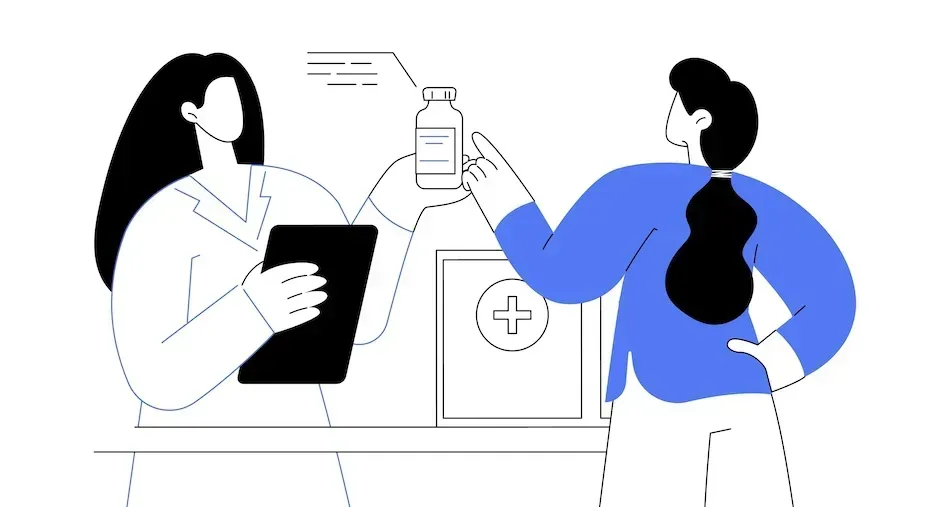ASH 2023: Richter’s Transformation Outcomes After CLL Medicines and CAR T-cell Therapy

Dr. Adam Kittai, CLL specialist and assistant professor at Ohio State University, recently presented research findings at ASH 2023 that shed light on treatment options for patients with Richter’s transformation. As a patient, understanding these findings is important to help you make the best treatment decision. Watch Dr. Kittai’s interview below or read the summary of his research findings.
Understanding Richter’s Transformation
Richter’s transformation occurs when CLL evolves into an aggressive form of lymphoma. Although rare, affecting 1 to 5% of CLL patients, its occurrence often results in poor outcomes. The transformation indicates a shift in the disease’s behavior, necessitating different treatment approaches.
Advances in CLL Treatment
In the past decade, CLL treatment has been revolutionized with the introduction of BTK inhibitors and BCL2 inhibitors, including ibrutinib (Imbruvica), acalabrutinib (Calquence), zanubrutinib (Brukinsa), venetoclax (Venclexta), and pirtobrutinib (Jaypirca). These new therapies have significantly changed the treatment landscape, moving away from traditional chemotherapy.
Dr. Kittai’s First Study: Outcomes for Richter’s Transformation Patients Who Did and Did Not Receive New CLL Therapies
Dr. Kittai’s study involved 240 CLL patients who developed Richter’s transformation without prior chemoimmunotherapy. This study is important as it compares the outcomes of patients who only received new CLL therapies (venetoclax, ibrutinib, acalabrutinib, and zanubrutinib) against those who didn't receive any treatment before the transformation.
Key Findings
- Patients who developed Richter’s transformation after new CLL therapies had a significantly lower overall survival (about 8 months) compared to those who hadn't received any prior treatment (40 to 70 months).
- Treatments for patients who had previously received new therapies for CLL were less effective, highlighting a critical area of unmet need.
Dr. Kittai’s Advice to Patients
Dr. Kittai advises patients who develop Richter’s transformation without prior therapy that their prognosis is similar to those with standard diffuse large B-cell lymphoma. However, for those who develop it after taking new CLL treatments, the recommendation is to seek clinical trials or new treatment avenues, as current options are less effective.
Dr. Kittai’s Second Study: Richter’s Transformation and CAR T-cell Therapy
The second part of Dr. Kittai’s presentation focused on using CAR T-cell therapy to treat Richter’s transformation.
Study Overview
- The study included 69 patients with Richter’s transformation treated with FDA-approved CAR T-cell therapies (axi-cel (Yescarta), liso-cel (Breyanzi), tisa-cel (Kymriah), and brexu-cel (Tecartus)).
- These patients were heavily pre-treated, indicating a prior lack of helpful treatment options.
Study Outcomes
- 47% of patients achieved a complete response, with the duration of response lasting 27 months in these cases. A complete response means the doctors couldn’t detect the patients’ disease after receiving CAR T-cell therapy. Duration of response refers to the length of time that patients achieved a response after receiving CAR T-cell therapy.
- For the remainder of patients, the progression-free survival after CAR T-cell therapy was around five months, with an overall survival of about nine months. Progression-free survival means how long it takes a patient’s disease to progress after receiving the treatment. Overall survival means the time from the start of treatment to the patient passing away.
The study suggests that CAR T-cell therapy can be effective for a subset of Richter’s transformation patients. Identifying these patients and implementing CAR T-cell therapy earlier in treatment is a key focus. Ongoing clinical trials, including ones combining CAR T-cell therapy with BTK inhibitors or PD-1 inhibitors like nivolumab (Opdivo), are exploring ways to enhance the efficacy of CAR T-cell therapy for Richter’s transformation.
Conclusion
Dr. Kittai’s research underscores the importance of tailored treatment strategies and continued research for patients facing Richter’s transformation. For patients, seeking expert opinions and exploring clinical trials can be pivotal in managing this rare and challenging complication of CLL.
Interested in Accelerating Research? Join HealthTree Cure Hub!
Are you interested in accelerating research toward a cure for CLL? We have created a powerful patient data portal named HealthTree Cure Hub for this very purpose. We invite you to join the 12,000-and-counting blood cancer patients who are collaborating with specialists through research surveys and studies in HealthTree Cure Hub. YOU are the key to improving CLL care. We are grateful for your time and support in helping us progress toward a CLL cure. Create your free HealthTree Cure Hub account by visiting the link below!
Dr. Adam Kittai, CLL specialist and assistant professor at Ohio State University, recently presented research findings at ASH 2023 that shed light on treatment options for patients with Richter’s transformation. As a patient, understanding these findings is important to help you make the best treatment decision. Watch Dr. Kittai’s interview below or read the summary of his research findings.
Understanding Richter’s Transformation
Richter’s transformation occurs when CLL evolves into an aggressive form of lymphoma. Although rare, affecting 1 to 5% of CLL patients, its occurrence often results in poor outcomes. The transformation indicates a shift in the disease’s behavior, necessitating different treatment approaches.
Advances in CLL Treatment
In the past decade, CLL treatment has been revolutionized with the introduction of BTK inhibitors and BCL2 inhibitors, including ibrutinib (Imbruvica), acalabrutinib (Calquence), zanubrutinib (Brukinsa), venetoclax (Venclexta), and pirtobrutinib (Jaypirca). These new therapies have significantly changed the treatment landscape, moving away from traditional chemotherapy.
Dr. Kittai’s First Study: Outcomes for Richter’s Transformation Patients Who Did and Did Not Receive New CLL Therapies
Dr. Kittai’s study involved 240 CLL patients who developed Richter’s transformation without prior chemoimmunotherapy. This study is important as it compares the outcomes of patients who only received new CLL therapies (venetoclax, ibrutinib, acalabrutinib, and zanubrutinib) against those who didn't receive any treatment before the transformation.
Key Findings
- Patients who developed Richter’s transformation after new CLL therapies had a significantly lower overall survival (about 8 months) compared to those who hadn't received any prior treatment (40 to 70 months).
- Treatments for patients who had previously received new therapies for CLL were less effective, highlighting a critical area of unmet need.
Dr. Kittai’s Advice to Patients
Dr. Kittai advises patients who develop Richter’s transformation without prior therapy that their prognosis is similar to those with standard diffuse large B-cell lymphoma. However, for those who develop it after taking new CLL treatments, the recommendation is to seek clinical trials or new treatment avenues, as current options are less effective.
Dr. Kittai’s Second Study: Richter’s Transformation and CAR T-cell Therapy
The second part of Dr. Kittai’s presentation focused on using CAR T-cell therapy to treat Richter’s transformation.
Study Overview
- The study included 69 patients with Richter’s transformation treated with FDA-approved CAR T-cell therapies (axi-cel (Yescarta), liso-cel (Breyanzi), tisa-cel (Kymriah), and brexu-cel (Tecartus)).
- These patients were heavily pre-treated, indicating a prior lack of helpful treatment options.
Study Outcomes
- 47% of patients achieved a complete response, with the duration of response lasting 27 months in these cases. A complete response means the doctors couldn’t detect the patients’ disease after receiving CAR T-cell therapy. Duration of response refers to the length of time that patients achieved a response after receiving CAR T-cell therapy.
- For the remainder of patients, the progression-free survival after CAR T-cell therapy was around five months, with an overall survival of about nine months. Progression-free survival means how long it takes a patient’s disease to progress after receiving the treatment. Overall survival means the time from the start of treatment to the patient passing away.
The study suggests that CAR T-cell therapy can be effective for a subset of Richter’s transformation patients. Identifying these patients and implementing CAR T-cell therapy earlier in treatment is a key focus. Ongoing clinical trials, including ones combining CAR T-cell therapy with BTK inhibitors or PD-1 inhibitors like nivolumab (Opdivo), are exploring ways to enhance the efficacy of CAR T-cell therapy for Richter’s transformation.
Conclusion
Dr. Kittai’s research underscores the importance of tailored treatment strategies and continued research for patients facing Richter’s transformation. For patients, seeking expert opinions and exploring clinical trials can be pivotal in managing this rare and challenging complication of CLL.
Interested in Accelerating Research? Join HealthTree Cure Hub!
Are you interested in accelerating research toward a cure for CLL? We have created a powerful patient data portal named HealthTree Cure Hub for this very purpose. We invite you to join the 12,000-and-counting blood cancer patients who are collaborating with specialists through research surveys and studies in HealthTree Cure Hub. YOU are the key to improving CLL care. We are grateful for your time and support in helping us progress toward a CLL cure. Create your free HealthTree Cure Hub account by visiting the link below!

about the author
Megan Heaps
Megan joined HealthTree in 2022. She enjoys helping patients and their care partners understand the various aspects of the cancer. This understanding enables them to better advocate for themselves and improve their treatment outcomes.
More on Conferences
Trending Articles

Get the Latest Chronic Lymphocytic Leukemia Updates, Delivered to You.
By subscribing to the HealthTree newsletter, you'll receive the latest research, treatment updates, and expert insights to help you navigate your health.
Together we care.
Together we cure.
3x Faster.








